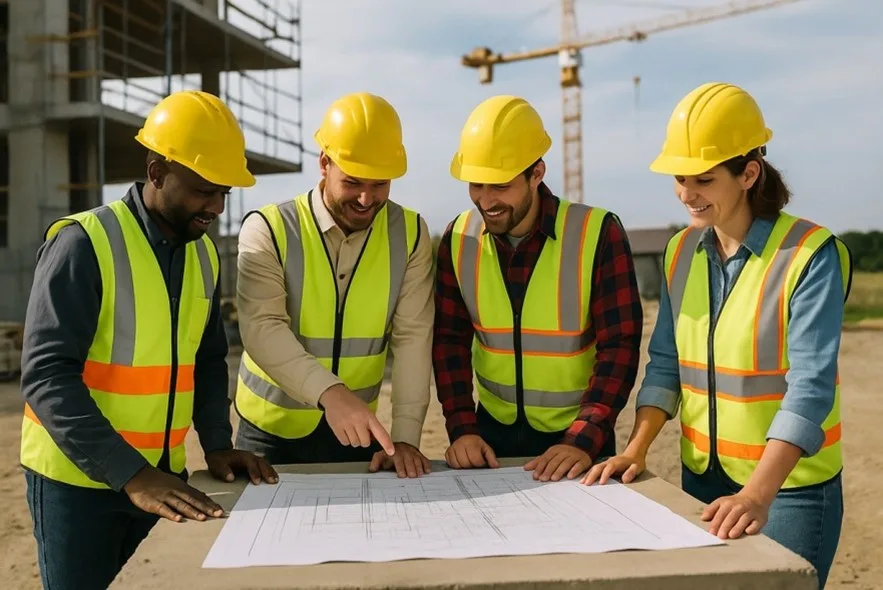Leading from the Ground Up: Lessons in Operational Leadership Across Sectors
- Introduction
Leadership is often spoken about from the top down, framed in theories developed in boardrooms, business schools, and executive retreats. Much of this formal conversation centres around structures, metrics, and positional authority. However, there exists a different kind of leadership, one that is formed not through titles or management courses, but through the experience of standing side-by-side with workers in unpredictable environments. This is what it means to lead from the ground up , to shape outcomes not with hierarchical power, but with presence, trust, and commitment in the field. It is leadership built in the dust of construction sites, the heat of mining camps, the noise of kitchens, and the constraints of small service businesses.
For over two decades, I have operated businesses in sectors where leadership is not abstract. It is visible, physical, and emotional. It shows up in how you respond to a last-minute problem, how you keep morale high when things go wrong, and how you treat people when they are under pressure. In these settings, leadership is about being there, taking responsibility, and helping others to succeed without needing to be asked. This article explores what I have learned through that journey, drawing on my experience across construction, civil infrastructure, mining, hospitality, and technical service delivery. My goal is not to theorise but to reflect, and to show that the strongest leadership often starts without a formal title, driven instead by a deep connection to the work and the people doing it.
- Early Leadership: Construction and Civil Infrastructure
My first real experience of leadership came through my construction business, Damien Reilly Construction, which I founded in the early 2000s. At the time, I was not thinking in terms of strategy or leadership models. I was thinking about getting the job done, making payroll, and keeping my team motivated in the face of shifting deadlines, weather disruptions, and planning delays. But looking back, it was here that I first learned how important visibility and fairness were on a job site. I quickly realised that people do not follow you because you own the company. They follow you if they see you work, if you treat them with consistency, and if you stand beside them when it counts.
In those early years, we were often managing several projects at once, each with its own site, schedule, client expectations, and challenges. There were no HR departments or office managers to delegate to. It was up to me to balance the books, organise procurement, review plans, and still be there for the lads when the first concrete was being poured. Every delay had a ripple effect, and the only way to keep things together was by building a team culture grounded in clear communication, mutual respect, and fairness. I learned to listen, to explain why certain calls were made, and to make sure people knew they were not just workers, but part of a shared outcome.
Leadership here meant being the first one on site and often the last to leave. When someone made a mistake, I owned the resolution alongside them. When people saw that, they responded. Trust was built not through contracts, but through behaviour.

And in this sector, where the weather can turn overnight and delivery times can slip for no fault of your own, having that trust made all the difference. It kept the team resilient, focused, and motivated. What this period taught me is that leadership often begins with showing up consistently, staying grounded, and ensuring your word means something when pressure hits.
- Leading Remote Teams: FIFO Mining Operations
When I took on the role of Project and HR Manager in the mining industry in Western Australia, I entered one of the most demanding leadership environments of my career. The conditions were harsh, the schedules relentless, and the stakes unusually high. These were fly-in fly-out worksites, remote locations where crews would spend weeks away from family, working under extreme heat, rigid timelines, and constant operational risk. In this context, leadership was not just about performance. It was about mental resilience, human connection, and keeping people stable in environments that could easily wear them down.

Unlike the relatively predictable rhythm of construction work, FIFO mining operations demanded a different emotional cadence. You had to be aware of morale at every stage of a rotation. I learned that a well-timed check-in could prevent burnout, that a quiet word after a shift could de-escalate tension before it turned into conflict, and that routines, even simple ones, created a sense of structure that helped people feel grounded. I introduced a three-tier rotation model to make sure people had breathing room and a sustainable pattern. We also developed a digital onboarding system, which helped new staff settle in faster, giving them clarity on expectations, safety protocols, and site norms before they even touched down on the ground.
What made a real difference was the decision to lead with empathy, not distance. In an industry where shouting orders or falling back on rigid rules can be common, I took the opposite approach. I made myself available. I asked questions instead of giving directives. I listened to frustrations, acknowledged them, and where possible, acted on them. That kind of leadership created stability. It lowered staff turnover. It opened up lines of communication. And when a crisis hit, whether it was a logistics breakdown or a team issue, people trusted that they could come to me early, before the situation escalated.
Leadership in remote mining was not about visibility in the traditional sense, because often I was not physically present on all sites at all times. Instead, it was about relational visibility. People knew I was engaged, responsive, and consistent. That presence, even when delivered remotely, anchored our teams. It reminded me that leadership is not just about being in control. It is about creating the conditions where others can perform under pressure, where safety and clarity are protected, and where teams feel they are not just part of an operation, but part of a shared responsibility.
- Adaptive Leadership in Hospitality: Reilly’s Irish Bar, Tavira
When I opened Reilly’s Irish Bar in Tavira, Portugal, I entered an entirely new leadership context, one where the social and emotional dynamics were as complex as the operational ones. Unlike construction or mining, where tasks are clearly defined and timelines often rigid, the hospitality sector lives on unpredictability. Every day was different. Customer moods, seasonal fluctuations, staff expectations, and local regulations constantly shifted the ground beneath our feet. Leading in this context meant becoming fluid without losing focus. It meant learning to balance high expectations with the very human rhythms of staff fatigue, cultural nuance, and interpersonal care.
From the very beginning, I understood that the bar would not succeed just by selling food and drink. It had to feel like something people were a part of. That meant the team I hired had to believe in that vision. I worked closely with each staff member, often side by side, and trained them not just in operations but in how to create an experience. We spoke multiple languages behind the counter. We hosted Irish music nights, charity events, and community football viewings. What developed was not just a business but a sense of belonging. And leadership in that setting required something different than rules or top-down control. It required responsiveness. It required care. It required the ability to read a room and read a person with the same level of attentiveness.

There were moments when the pressure to perform clashed with the need to preserve well-being. Long summer nights could stretch into the early hours. Mistakes would happen. Tempers would rise. I learned that the most powerful leadership tool in these moments was not discipline but pause. Taking a breath, stepping outside with someone for a five-minute conversation, or recognising when someone needed to swap shifts for personal reasons without fear of judgment. These small human gestures kept the team stable, especially when the volume of business surged beyond expectation.
The biggest leadership lesson I took from hospitality was the need to design environments where people feel seen. In a sector known for high turnover, we maintained continuity because people felt part of something more than a wage. And that feeling came from leadership that showed up emotionally, not just functionally. It taught me that culture is not built in workshops. It is built in moments. In how you greet someone, how you handle pressure, how you celebrate small wins. Those moments, added up over time, form the foundation of leadership that lasts, even in an industry built on speed and change.
- Solo Leadership in Technical Services: TVpro.ie

Transitioning into solo entrepreneurship with TV Pro Ireland marked a turning point in my leadership evolution. Unlike previous ventures where teams were present and delegation was essential, here the leadership challenge was internal. Every decision, every client interaction, every failure and success landed directly on me. There was no safety net, no assistant to follow up, no manager to escalate problems to. It was a different kind of leadership, quieter but in many ways more demanding. It asked for discipline, consistency, and the ability to self-motivate while wearing every operational hat, from technician and customer service agent to accountant and digital marketer.
What I learned quickly was that leadership in a solo environment is not about commanding others, but about mastering systems that allow you to consistently show up at your best. The work was often physical, involving complex installations, cable routing, diagnostics, and hardware configuration. But the real leadership work happened in how I engaged with clients. Many were older, rural residents who felt overwhelmed by modern technology. They needed more than a service provider. They needed someone patient enough to explain the process and responsive enough to handle their concerns long after the installation was finished. That kind of care built long-term trust and, over time, a community of repeat clients who referred friends and family.

As demand grew, I began training subcontractors to extend the reach of the business. This was another test of leadership, how to scale quality when you are no longer present at every job. I created a short service protocol, based not just on technical steps, but on how to treat the customer. Things like arriving five minutes early, removing shoes inside homes, explaining each part of the process, and following up with a call a few days later. These soft touches were not about brand image. They were about values. And they had to be taught through modeling, not instruction. I never asked anyone to do something I hadn’t done hundreds of times myself.
Perhaps the greatest insight I gained from this chapter is that leadership is as much about rhythm as it is about vision. Building a routine that balances service excellence with personal wellbeing is essential when there is no one else to delegate to. In the solitude of solo business, your mindset becomes your management system. If you do not build trust with yourself, by keeping commitments, pacing your energy, and staying present, it becomes impossible to sustain trust with clients. In that sense, solo leadership becomes a mirror. It shows you your blind spots, your limits, and your potential. And if you are willing to learn from that mirror, it can become your most powerful leadership teacher.
- Conclusion and Final Reflection
Looking back across two decades of leadership in construction sites, mining operations, hospitality venues, and technical service delivery, what stands out is not the scale of the operations, the sectors involved, or the complexity of the environments. What endures is a set of values and practical disciplines that proved effective in each setting: show up, listen closely, act fairly, and deliver consistently. These are not abstract ideals. They are habits forged in the reality of unpredictable conditions, tight deadlines, and limited resources. In these contexts, leadership is not a title granted by an organization, but a responsibility you earn every day through presence, clarity, and commitment.
The contrast between formal leadership frameworks and the reality of frontline leadership is sharp. In boardrooms and MBA programs, we often hear about strategic alignment, cascading goals, and organizational transformation. These are valid concepts, but they must be grounded in the lived experience of leading people who are tired, skeptical, or under pressure. On a construction site with rain in the forecast and a deadline looming, leadership comes down to whether your team trusts you to make a decision, share the truth, and stand beside them in the consequences. In a mining camp far from home, leadership is whether someone feels seen after a fourteen-hour shift. In a solo business, leadership is whether you still have the energy to be kind to the next customer after twelve jobs and a missed lunch. These are the moments that reveal character and define culture.
What I have learned is that the most powerful leadership tools are human ones: empathy that sees the person behind the task, structure that provides stability in chaos, and presence that reminds people they are not alone. Whether managing a crew of thirty or facing the day’s work alone, the core remains the same: take responsibility, communicate clearly, act with integrity. These principles are portable across any industry or country. They build trust, reduce turnover, and unlock performance in ways that metrics alone can never capture.
Leading from the ground up is not a phase of leadership. It is the foundation. And the more the world changes, the more this grounded, relational, and responsive style of leadership will be needed, especially in sectors where lives, livelihoods, and community trust are on the line.

